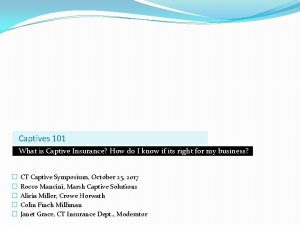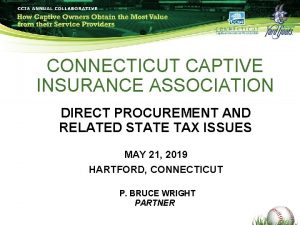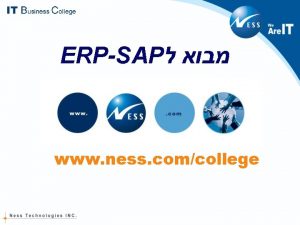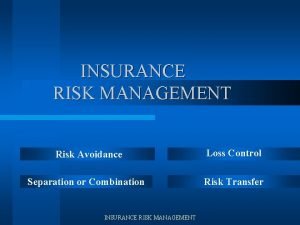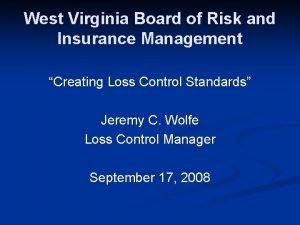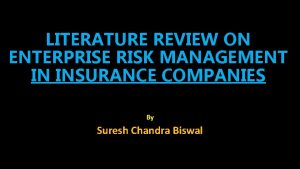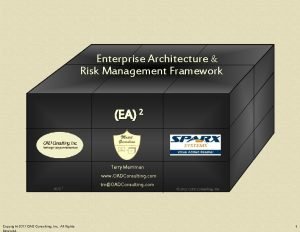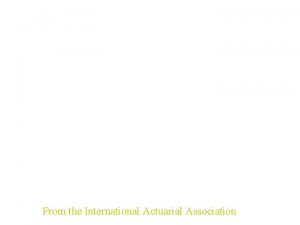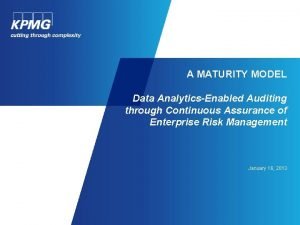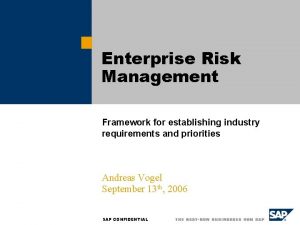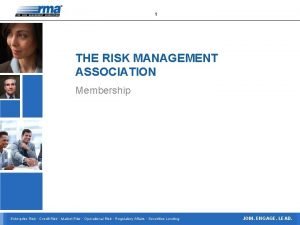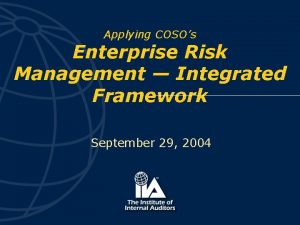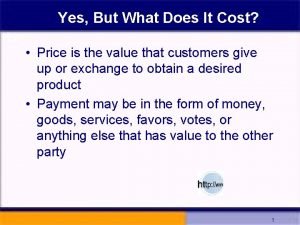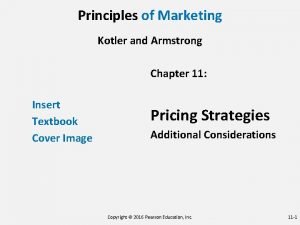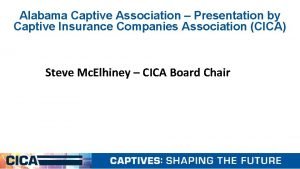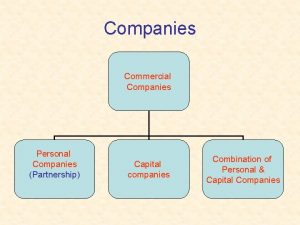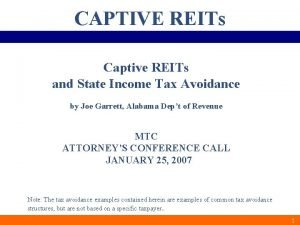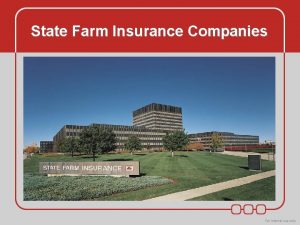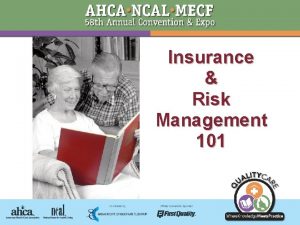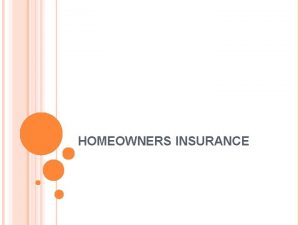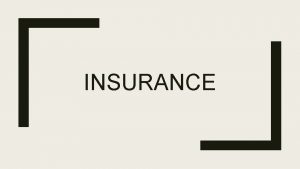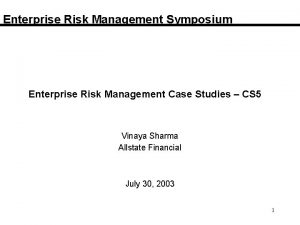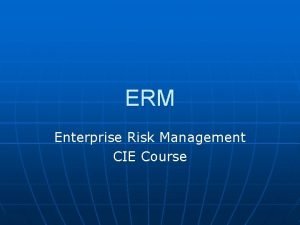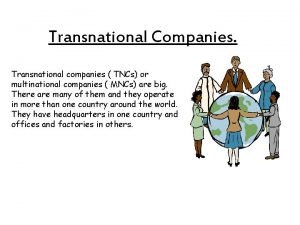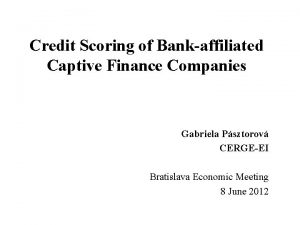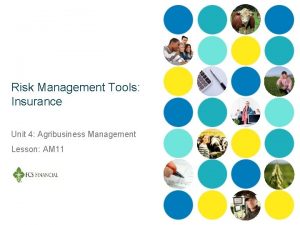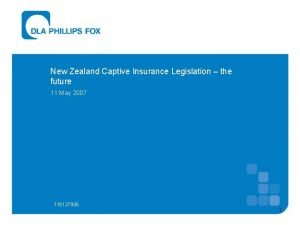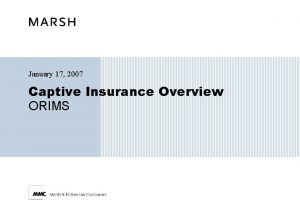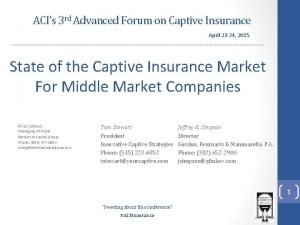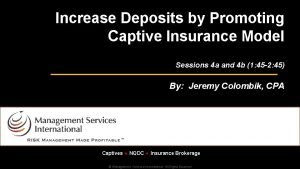ENTERPRISE RISK CAPTIVE INSURANCE COMPANIES RISK MANAGEMENT TOOLS

























- Slides: 25

ENTERPRISE RISK CAPTIVE INSURANCE COMPANIES: RISK MANAGEMENT TOOLS FOR FAMILY HELD BUSINESSES AFHE 2018 ANNUAL CONFERENCE APRIL 20, 2018 Jeffrey K. Simpson David M. Di. Mayo Gordon, Fournaris & Mammarella, P. A. Oxford Risk Management Group JSimpson@gfmlaw. com DDi. Mayo@Oxford. RMG. com (302) 652 -2900 (410) 472 -6490 www. gfmlaw. com www. Oxford. RMG. com @Jeffrey. KSimpson

Objectives: • Define and describe Enterprise Risk Captives • Show they can help family held enterprises • Explain how they work • Discuss tax issues and how to avoid them 2

What is a Captive? • Property & Casualty Insurance Company • A risk management tool utilized to cover the unique risks of an operating company • Provides coverage for specialized risks which may not be available or may be too costly to obtain through traditional insurance providers • A bona fide insurance company, subject to approval and regulatory oversight by the insurance regulators in a chosen domicile 3

Common Types of Captive • Member Owned Group • Risk Retention Group • Traditional Pure Captive s Today’ Focus! • Enterprise Risk Captive 4

What is an Enterprise Risk Captive? • Serves private company/family held business • Covers non-traditional risks and gaps in commercial coverage • Elects special treatment under IRC Section 831(b) • Also may be called • Small Captive • Micro-Captive • 831(b) Captive 5

What are non-traditional risks? Traditional Risks – things typically covered • • • Workers Comp Auto General Liability Professional Liability Property Damage Non-Traditional Risks – things NOT typically covered • Exposed but uninsured • Loss of business income • Gaps in commercial coverage • Deductibles • Exclusions 6

Insurable Risks That May Result in Loss of Business Income • Business Interruption • Contract Penalty and Failure to Perform on Contract • Deductible Reimbursement • Defense Cost Reimbursement • Difference in Conditions Mechanical Breakdown Loss of Key Employee Loss of Licensure Legislative and Regulatory Changes • Reputational Risk • Suppliers/Supply Chain Interruption • • 7

Basic Captive Structure Shareholders Insurance Premium Operating Company Insurance Coverage Captive Insurance Company 8

Why Implement a Captive? Risk Management and Other Benefits • Greater Control over Claims • Pricing Stability • Fill Gaps in Existing Coverage • Purchase Based on Need • Underwriting Flexibility • Investment Income • Incentive for Loss Control • Reduced Insurance Costs • Access Reinsurance Market • Improved Claims Review and Processing • Capture Underwriting Profit 9

Underwriting • Assemble Current Insurance Information • Review Current Policies and Endorsements • Analyze Five Year Loss Runs • Three Year Summary of Coverage • Identify Trends in Premium History • Underwriting • Understanding the operating company • Discuss reasonable coverage applicable to industry and unique business • Identify Self-Insured Exposures • Identify Uninsured Loss Experience • Adequacy of Policy Limits 10

Third Party Review and Analysis • Independent Third Party Risk Analysis • Coverage Chart • Gap Identification • Total Cost of Risk (TCOR) Analysis • Enterprise Risk Exposure Review • Risk Selection • Review by Independent P&C Broker • Identify Relevant Coverage • Avoid Duplicate Coverage • Independent Third Party Actuarial Analysis • Rate Promulgation • Peer Review of Pricing Methodology • Feasibility Study 11

Insurance Premium Fronting Carrier Operating Company ns nd Flexible Ownership Options Captive Owner e ivid tio ibu r t s i Premium Reinsurance Insurance Policy Underwriting Profit * Captive D D *After Claims less Expenses 12

$1, 000, 000 Claim from Participant Insured Claim Example: First dollar risk sharing , 000 0 $20 20 f. C %o laim Captive which filed the Claim Fronting Carrier $800 , 000 80% of C laim Assumptions: • Your Captive Premium is $1, 000 • Total Written Premium = $500 MM • Your Portion of Claim = 0. 2% • Your Captive is Responsible for $1, 600 All Other Captives Share Risk $1, 600 Your Captive 13

Tax treatment • How does 831(b) work? • Current IRS environment • Managing to be conservative and avoid abuse 14

How does 831(b) work? • Insurance company taxed only on investment income and not on premium income, if: 1. No more than $2. 3 million annual premium ($2. 2 Million Plus Inflation index) AND 2. One of two diversification tests: A. No more than 20% of risk from a single policy holder OR B. No estate planning ownership structure (Generally, no wealth transfer, lineal descendants cannot own more of captive than insured enterprise) 15

Current IRS Environment Abuses? What the IRS Doesn’t Like Deferral + Conversion = Recipe for Mischief • • Premiums • No Actuarial Support • Inflated Coverages • Business Risk • Bogus Risk • • Pools • Low Loss Ratio • Premium Allocation Tax Motivation • Promoters • Estate Planning 16

Current IRS Environment IRS Activity • Dirty Dozen List • Evolving Language • Notice 2016 -66 • Overbroad? • Audits • Owners and managers • Tax court cases • Avrahami • 100 s to follow 17

Current IRS Environment Industry is engaged – ongoing dialogue • Educating IRS and DC on insurance • Results • PATH Act increased limit and restricted only estate planning • PATH Act clarifications passed in March, 2018 • Notice 2016 -66 filing deadline delayed 18

Enterprise Risk Group Captive Solution • Alternative Risk Finance Solution to 831(b) • Coupling a Traditional Captive Insurance Design with ERM • Provides a Mechanism to Achieve Similar Risk Management and Economic Goal/Objectives • Pros and Cons 19

IRS Scrutiny AVOID DOING THESE THINGS! • Not Following the Safe Harbor Guidelines • No Real Distribution of Risk • Paying Excessive Premium for your Coverage • Insuring Unreasonable Risks • No Claims Experience or Claims Layering • Treating Captive Assets as a Personal Checkbook • High Deductible Risk Pools or Retroactive Policy Issuance • Circular Transactions • Lack of Business Purpose • Investment Plans that Don’t Make Sense • Lack of Independent Actuarial Analysis 20

Implementation Process Initial Consultation Informal Feasibility Complete Feasibility Study Application to Insurance Regulators Domicile Selection Approval Process Risk Analysis, Underwriting and Compliance Closing Procedure Analysis Engagement Process 21

Captive Manager Actuarial Firm Legal Counsel P&C Broker and Risk Analysis Firm* Audit Firm *Advisors are independent of Oxford Tax Counsel* Financial Advisor* 22

• Significant Annual Recurring Revenue • Enterprise Risk Exposure • Willing to invest time to explore risk management solutions • Sophisticated business owner • Across All Industries: • • • Agriculture Transportation/Logistics Construction Entertainment/Professional Athlete Medical Real Estate IT Oil Drilling Manufacturing 23

How to Build a Conservative Captive • Design with risk management as the primary focus • Adhere to IRS Revenue Rulings and all available guidance • Assure that the captive is operated as a bona fide property & casualty insurance company with meaningful claims • Underwrite policies that offer coverage at appropriate premium levels • Avoid structures that are “too good to be true” in order to generate predictable results 24

Questions? Jeffrey K. Simpson Gordon, Fournaris & Mammarella, P. A. JSimpson@gfmlaw. com (302) 652 -2900 www. gfmlaw. com @Jeffrey. KSimpson David M. Di. Mayo Oxford Risk Management Group DDi. Mayo@Oxford. RMG. com (410) 472 -6490 www. Oxford. RMG. com 25
 831b captives
831b captives Enterprise risk captive
Enterprise risk captive Alan franklin
Alan franklin Insurance captives 101
Insurance captives 101 Connecticut surplus lines tax
Connecticut surplus lines tax Sweden insurance market
Sweden insurance market Sap מערכת
Sap מערכת Risk management in insurance
Risk management in insurance Risk management west virginia
Risk management west virginia Decision processes wharton
Decision processes wharton Insurance proposals fire insurance
Insurance proposals fire insurance Literature review on enterprise risk management
Literature review on enterprise risk management Enterprise risk management for credit unions
Enterprise risk management for credit unions Enterprise architecture risk management
Enterprise architecture risk management Enterprise risk management for financial institutions
Enterprise risk management for financial institutions Internal audit data analytics maturity
Internal audit data analytics maturity Omb a 123
Omb a 123 Enterprise risk management pharmaceutical industry
Enterprise risk management pharmaceutical industry Bindesh rach
Bindesh rach Enterprise risk management association
Enterprise risk management association Enterprise risk management integrated framework
Enterprise risk management integrated framework Market risk credit risk operational risk
Market risk credit risk operational risk Captive pricing
Captive pricing Armstrong chapter 11
Armstrong chapter 11 Captive-product pricing
Captive-product pricing Captive-product pricing
Captive-product pricing



